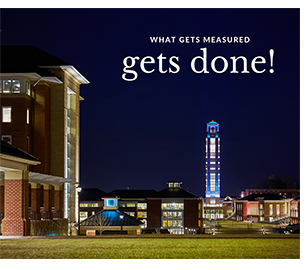Introduction to Assessment

One of the greatest challenges facing higher education today is the ability to demonstrate the quality of education that is provided. Institutional effectiveness, in all areas—curricular and co-curricular, is vital to the success of every university. This pressing challenge for accountability, effectiveness, and change has brought assessment, strategic planning, and budget planning into the forefront of the administrative lives of higher education.
Institutional effectiveness has become a discipline that helps protect the institution from veering away from its mission and goals. An effectiveness program focuses on  Educational Programs, Administrative Support Services, Academic and Student Support Services, Facilities Management and Services, and Community/Public Service. It holds these areas accountable to their purposes and objectives.
Educational Programs, Administrative Support Services, Academic and Student Support Services, Facilities Management and Services, and Community/Public Service. It holds these areas accountable to their purposes and objectives.
The process of institutional effectiveness includes a continuous planning, implementation, assessment, improvement cycle that is applied at each level of the organization.
As institutions have developed assessment processes and sought to establish broad based strategic planning procedures, it has become apparent that there is a need to integrate assessment and strategic planning processes with the budget planning process. It is important to recognize the elements of the assessment cycle and to effectively “close the loop” in a comprehensive and systematic fashion.
A Brief History
What Is Assessment?
Assessment is simply an appraisal. So, what do we assess in a higher education institution? We assess the quality of our effectiveness and efficiency in fulfilling our mission and goals. Although the statement is simple, making it a natural and ongoing process of the university culture is a bit more complex. Although in the initial stages of the assessment movement the focus was on learning outcomes, in recent times the emphasis has broadened to all areas of the institution, curricular and co-curricular.
Why We Do Assessment?
Assessment is the tool that gives incentive to planning. It helps set realistic goals. It is the glue that brings the strategic planning and budget together.
Stakeholders are essential to the process of assessment. Whether external or internal, they set  expectations and performance goals and are the ultimate judges of the institution’s quality. Common stakeholders of an institution of higher education are students, faculty, staff, community, parents, alumni, benefactors, and the board. Each group has every right to expect a report on the quality of our education and an accounting of the use of the revenues received.
expectations and performance goals and are the ultimate judges of the institution’s quality. Common stakeholders of an institution of higher education are students, faculty, staff, community, parents, alumni, benefactors, and the board. Each group has every right to expect a report on the quality of our education and an accounting of the use of the revenues received.
Assessment brings change—or at least it should. This can be very threatening at times, especially if the demand for accountability and performance comes from outside the institution. Presidents of universities and colleges are anxious to maintain accreditation status, to receive funding, and to be able to recruit competitively. Assessment results usually indicate the “health” of the institution. Any deviation from positive indicators can affect relationships with these outside entities.